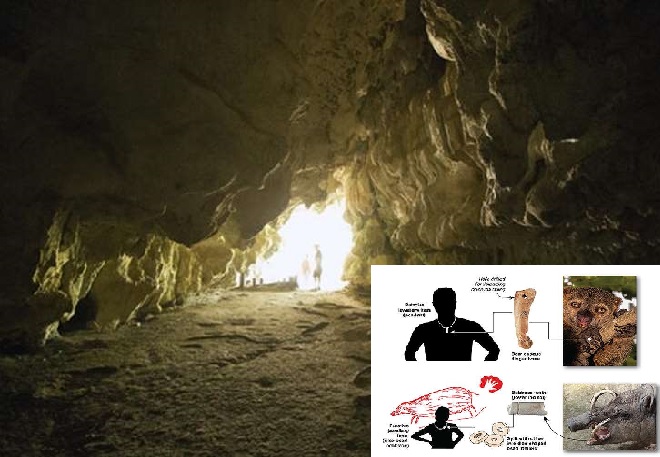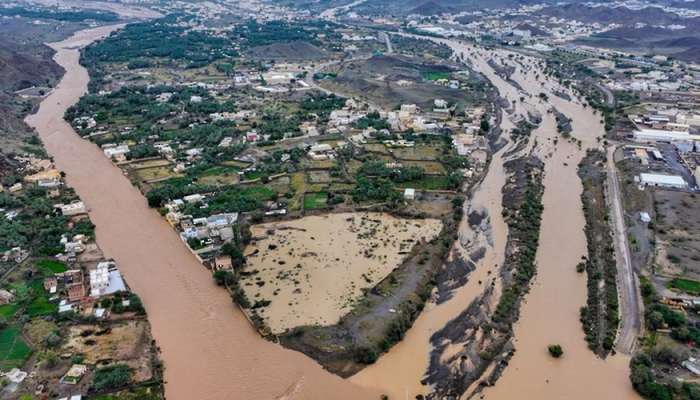Archaeologists Find 30,000-Year-Old Jewelry in Indonesia
Mon 10 Apr 2017, 08:25:56

We have thousands of examples of Ice Age works from Europe—curvy Venus figurines, beads and other carved artifacts, and cave paintings of saber-toothed cats and mammoths dating back some 35,000 years. Those sites are also the best documented in the world, having been studied since the 19th century.
Evidence of the earliest art on other continents is much more scant, but it's increasingly being recorded across the world. In the latest study that attempts to offer a more complete picture of human creativity, researchers report that they’ve discovered jewelry and pigments inside of an Ice Age cave in Indonesia that are between 22,000 and 30,000 years old. They published their findings today in the Proceedings of the National Academy of Sciences.
Archaeologist Adam Brumm and his colleagues have been seeking traces of the earliest inhabitants of Sulawesi. The island is shaped a bit like a withered starfish and it’s the biggest in Wallacea, the region between the Asian and Australian continental shelves.
The researchers made headlines in 2014 when they discovered [PDF] that cave artwork among the towering karst formations on Sulawesi’s southwestern peninsula could be among the oldest in the world. Using a precise dating method, they documented hand stencils that are nearly 40,000 years old. They also found a figurative painting of pig-deer (or babirusa) that was more than 35,000 years old, rivaling the age of the animal paintings inside France’s famous Chauvet Cave.
As detailed in the current study, the archaeologists excavated the floor of another cave known as Leang Bulu Bettue.
“We started digging at this limestone cave because it was the only site I had seen in the region which seemed to have escaped the ravages of erosion and disturbance from local farmers digging up the guano-rich cave earth for use as fertilizer,” Brumm, who is an associate professor at Griffith University in Australia, tells mental_floss. The cave also had rock art preserved on its walls and ceilings—red and purple hand stencils that are identical to some of the nearby cave paintings described in 2014.
So, the researchers suspected they would find some undisturbed archaeological deposits—and indeed they did.
They dug up
stone artifacts carved with geometric patterns like Xs and parallel lines, as well as chunks of ochre, a natural pigment that was used in cave painting. They unearthed a perforated finger bone from a local bear cuscus, a kind of marsupial, that was possibly used for a necklace, and they found unfinished disk-shaped beads made from a babirusa tooth. The artifacts date to between 22,000 and 30,000 years ago.
Brumm says that of Wallacea’s 2000 islands, only seven have so far yielded archaeological deposits from the Pleistocene, the epoch when the last Ice Age occurred. Therefore, the total number of artifacts from the region is “pitifully small,” he says, perhaps numbering only a dozen or so.
“This profound imbalance in research intensity makes it extremely difficult to draw meaningful comparisons between the ‘Ice Age’ cultures of Wallacea and Europe,” Brumm says.
The fact that the newly discovered artifacts were made from the bones of animals that are only found on Sulawesi suggests that early humans were “drawn to the symbolic potential of the exotic species they encountered” when they colonized this region, Brumm says.
“This speaks of a flexibility in early human culture in this little understood part of the ‘Ice Age’ world—an ability to adapt existing art forms and symbolic culture to entirely new environments and ecosystems,” Brumm adds. And he thinks it’s exactly this kind of flexibility that would have allowed people from this region to colonize an isolated continent like Australia around 50,000 years ago.
Archaeologist Iain Davidson, an emeritus professor at the University of New England in Australia, who wasn’t involved in the study, similarly thinks the same skills that allowed people to make watercraft and navigate across Wallacea “should have enabled them to represent their world symbolically.”
Davidson calls the discovery very important "primarily because it adds to the emerging picture of an early rock art world in the region where there has been thought to be none; now it is clear that there is,” Davidson tells mental_floss. “It was always likely, but maybe only a matter of looking and using the appropriate techniques, which is what this team has done really well.”
Evidence of the earliest art on other continents is much more scant, but it's increasingly being recorded across the world. In the latest study that attempts to offer a more complete picture of human creativity, researchers report that they’ve discovered jewelry and pigments inside of an Ice Age cave in Indonesia that are between 22,000 and 30,000 years old. They published their findings today in the Proceedings of the National Academy of Sciences.
Archaeologist Adam Brumm and his colleagues have been seeking traces of the earliest inhabitants of Sulawesi. The island is shaped a bit like a withered starfish and it’s the biggest in Wallacea, the region between the Asian and Australian continental shelves.
The researchers made headlines in 2014 when they discovered [PDF] that cave artwork among the towering karst formations on Sulawesi’s southwestern peninsula could be among the oldest in the world. Using a precise dating method, they documented hand stencils that are nearly 40,000 years old. They also found a figurative painting of pig-deer (or babirusa) that was more than 35,000 years old, rivaling the age of the animal paintings inside France’s famous Chauvet Cave.
As detailed in the current study, the archaeologists excavated the floor of another cave known as Leang Bulu Bettue.
“We started digging at this limestone cave because it was the only site I had seen in the region which seemed to have escaped the ravages of erosion and disturbance from local farmers digging up the guano-rich cave earth for use as fertilizer,” Brumm, who is an associate professor at Griffith University in Australia, tells mental_floss. The cave also had rock art preserved on its walls and ceilings—red and purple hand stencils that are identical to some of the nearby cave paintings described in 2014.
So, the researchers suspected they would find some undisturbed archaeological deposits—and indeed they did.
They dug up
stone artifacts carved with geometric patterns like Xs and parallel lines, as well as chunks of ochre, a natural pigment that was used in cave painting. They unearthed a perforated finger bone from a local bear cuscus, a kind of marsupial, that was possibly used for a necklace, and they found unfinished disk-shaped beads made from a babirusa tooth. The artifacts date to between 22,000 and 30,000 years ago.
Brumm says that of Wallacea’s 2000 islands, only seven have so far yielded archaeological deposits from the Pleistocene, the epoch when the last Ice Age occurred. Therefore, the total number of artifacts from the region is “pitifully small,” he says, perhaps numbering only a dozen or so.
“This profound imbalance in research intensity makes it extremely difficult to draw meaningful comparisons between the ‘Ice Age’ cultures of Wallacea and Europe,” Brumm says.
The fact that the newly discovered artifacts were made from the bones of animals that are only found on Sulawesi suggests that early humans were “drawn to the symbolic potential of the exotic species they encountered” when they colonized this region, Brumm says.
“This speaks of a flexibility in early human culture in this little understood part of the ‘Ice Age’ world—an ability to adapt existing art forms and symbolic culture to entirely new environments and ecosystems,” Brumm adds. And he thinks it’s exactly this kind of flexibility that would have allowed people from this region to colonize an isolated continent like Australia around 50,000 years ago.
Archaeologist Iain Davidson, an emeritus professor at the University of New England in Australia, who wasn’t involved in the study, similarly thinks the same skills that allowed people to make watercraft and navigate across Wallacea “should have enabled them to represent their world symbolically.”
Davidson calls the discovery very important "primarily because it adds to the emerging picture of an early rock art world in the region where there has been thought to be none; now it is clear that there is,” Davidson tells mental_floss. “It was always likely, but maybe only a matter of looking and using the appropriate techniques, which is what this team has done really well.”
No Comments For This Post, Be first to write a Comment.
Most viewed from International
Most viewed from World
AIMIM News
Owaisi Begins Election Campaign in Hyderabad
Apr 13, 2024
Bring back Indian workers in Israel: Owaisi
Apr 13, 2024
Darussalam to be closed tomorrow
Apr 06, 2024
Latest Urdu News
Most Viewed
May 26, 2020
Do you think Ruturaj Gaikwad would be a good captain for Chennai Super Kings?
Latest Videos View All
Like Us
Home
About Us
Advertise With Us
All Polls
Epaper Archives
Privacy Policy
Contact Us
Download Etemaad App
© 2024 Etemaad Daily News, All Rights Reserved.









.jpg)
.jpg)
.jpg)





























